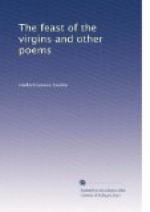[39] Wah-kahn-dee—The lightning.
[40] The Bloody River—the Red River was so called on account of the numerous Indian battles that have been fought on its banks. The Ojibways say that its waters were colored red by the blood of many warriors slain on its banks in the fierce wars between themselves and the Dakotas.
[41] Tah—The Moose. This is the root-word for all ruminating animals: Ta-tanka, buffalo—Ta-toka, mountain antelope—Ta-hinca, the red deer—Ta-mdoka, the buck-deer—Ta-hinca-ska, white deer (sheep).
[42] Hogahn—Fish. Red Hogan, the trout.
[43] Tipsanna (often called tipsinna) is a wild prairie-turnip used for food by the Dakotas. It grows on high, dry land, and increases from year to year. It is eaten both cooked and raw.
[44] Rio Tajo (or Tagus), a river of Spain and Portugal.
[45]
* * * * “Bees of Trebizond—
Which from the sunniest flowers that glad
With their pure smile the gardens round,
Draw venom forth that drives men mad.”
_—Thomas Moore_.
[46] Skee-skah—The Wood-duck.
[47] The Crocus. I have seen the prairies in Minnesota spangled with these beautiful flowers in various colors before the ground was free from frost. The Dakotas call them “frost-flowers.”
[48] The “Sacred Ring” around the Feast of the Virgins is formed by armed warriors sitting, and none but a virgin must enter this ring. The warrior who knows is bound on honor, and by old and sacred custom, to expose and publicly denounce any tarnished maiden who dares to enter this ring, and his word cannot be questioned—even by the chief. See Mrs. Eastman’s Dacotah, p. 64.
[49] Prairie’s Pride.—This annual shrub, which abounds on many of the sandy prairies in Minnesota, is sometimes called “tea-plant,” “sage-plant,” and “red-root willow.” I doubt if it has any botanic name. Its long plumes of purple and gold are truly the “pride of the prairies.”
[50] The Dakotas consider white cedar “Wakan,” (sacred). They use sprigs of it at their feasts, and often burn it to destroy the power of evil spirits. Mrs. Eastman’s Dacotah, p. 210.
[51] Tahkoo-skahng-skahng. This deity is supposed to be invisible, yet everywhere present; he is an avenger and a searcher of hearts. (Neill’s Hist. Minn., p. 57). I suspect he was the chief spirit of the Dakotas before the missionaries imported “Wakan-Tanka” (Great Spirit).
[52] The Dakotas believe in “were-wolves” as firmly as did our Saxon ancestors, and for similar reasons—the howl of the wolf being often imitated as a decoy or signal by their enemies the Ojibways.
[53] Shee-sho-kah—The Robin.
[54] The Dakotas call the Evening Star the “Virgin Star,” and believe it to be the spirit of the virgin wronged at the feast.




